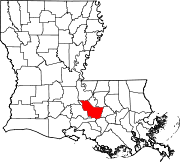Maringouin, Louisiana
Maringouin, Louisiana | |
|---|---|
Town | |
CDT) | |
| Area code | 225 |
| FIPS code | 22-48610 |
| Website | www |
Maringouin is a town in
Etymology
The name, which is
Geography
Maringouin is located in northern Iberville Parish at 30°29′27″N 91°31′8″W / 30.49083°N 91.51889°W (30.490911, -91.519023).[6] Its northern border is the Pointe Coupee Parish line, and its eastern border is Bayou Grosse Tete. Louisiana Highway 77 passes through the center of the town, leading north 5 miles (8 km) to Livonia and southeast 6 miles (10 km) along Bayou Grosse Tete to Rosedale. Louisiana Highway 76 leads south from Maringouin 7 miles (11 km) along Bayou Maringuoin to Interstate 10 at Ramah.
According to the United States Census Bureau, Maringuoin has a total area of 0.73 square miles (1.9 km2), all of it recorded as land.[3] The town is part of the French speaking Acadiana region of Louisiana.
Demographics
| Census | Pop. | Note | %± |
|---|---|---|---|
| 1910 | 447 | — | |
| 1920 | 399 | −10.7% | |
| 1930 | 518 | 29.8% | |
| 1940 | 708 | 36.7% | |
| 1950 | 898 | 26.8% | |
| 1960 | 1,168 | 30.1% | |
| 1970 | 1,365 | 16.9% | |
| 1980 | 1,291 | −5.4% | |
| 1990 | 1,149 | −11.0% | |
| 2000 | 1,262 | 9.8% | |
| 2010 | 1,098 | −13.0% | |
| 2020 | 891 | −18.9% | |
| U.S. Decennial Census[7] | |||
| Race | Number | Percentage |
|---|---|---|
White (non-Hispanic)
|
105 | 11.78% |
Black or African American (non-Hispanic)
|
770 | 86.42% |
Native American
|
1 | 0.11% |
Other/Mixed
|
10 | 1.12% |
Latino
|
5 | 0.56% |
As of the 2020 United States census, there were 891 people, 393 households, and 248 families residing in the town.
At the
There were 421 households, out of which 40.4% had children under the age of 18 living with them, 44.7% were married couples living together, 27.6% had a female householder with no husband present, and 22.1% were non-families. 20.2% of all households were made up of individuals, and 11.6% had someone living alone who was 65 years of age or older. The average household size was 3.00 and the average family size was 3.43.
In the town, the population was spread out, with 33.1% under the age of 18, 9.3% from 18 to 24, 24.3% from 25 to 44, 20.2% from 45 to 64, and 13.1% who were 65 years of age or older. The median age was 32 years. For every 100 females, there were 80.8 males. For every 100 females age 18 and over, there were 73.7 males.
The median income for a household in the town was $23,816, and the median income for a family was $28,359. Males had a median income of $27,917 versus $19,500 for females. The
Connection to historical slave sale
In 1838, the
Notable people
- Rick Ward III, state senator from District 17 since 2012[13]
References
- Louisiana Secretary of State. December 8, 2018. Retrieved December 8, 2018.
- ^ "2020 U.S. Gazetteer Files". United States Census Bureau. Retrieved March 20, 2022.
- ^ a b "Geographic Identifiers: 2010 Census Summary File 1 (G001): Maringouin town, Louisiana". American Factfinder. U.S. Census Bureau. Archived from the original on February 13, 2020. Retrieved April 4, 2018.
- ^ "City and Town Population Totals: 2010-2020". United States Census Bureau. Retrieved August 5, 2021.
- CiteSeerX 10.1.1.1015.3344.
- ^ "US Gazetteer files: 2010, 2000, and 1990". United States Census Bureau. February 12, 2011. Retrieved April 23, 2011.
- ^ "Census of Population and Housing". Census.gov. Retrieved June 4, 2015.
- ^ "Explore Census Data". data.census.gov. Retrieved December 29, 2021.
- ^ "U.S. Census website". United States Census Bureau. Retrieved January 31, 2008.
- ^ Matthew Quallen. "Beyond the 272 Sold in 1838, Plotting the National Diaspora of Jesuit-Owned Slaves". The Hoya. Archived from the original on May 1, 2017. Retrieved April 28, 2017.
- ^ Noel King. "Episode 767: Georgetown, Louisiana, Part Two". NPR.org. Planet Money. Retrieved April 28, 2017.
- ^ "Georgetown Shares Slavery, Memory, and Reconciliation Report, Racial Justice Steps". September 2016. Retrieved April 28, 2017.
- ^ "Senator Rick Ward, III". labi.org. Archived from the original on December 19, 2013. Retrieved July 17, 2013.

